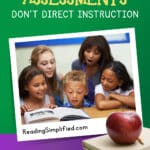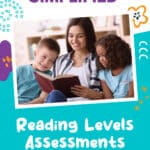
We are desperate as teachers (especially this year more than ever) to see our students' reading achievement accelerate. As the school year begins, we want to assess our kids as quickly as we can, so we will know how to teach them at their instructional match.
And get them progressing!
But a common issue in our teaching culture is that we are assessing kids just by using reading levels, and then we're trying to make instructional decisions based on that. That turns out to be a really hard trick. Reading levels are useful for sure, but they don't tell us as much information about our students' reading as we think.
So, watch the video below to discover some of the weaknesses of the reading levels assessments, as well as some of the faults in reading leveling system themselves....
Reading Levels Assessments DON’T Tell You What to Teach
- [01:23] - The weaknesses in reading leveling systems
- [03:42] - Why reading levels assessments are inadequate
- [05:34] – The shocking truth that reading levels assessments do not tell you what to teach and what to do about that!
- [07:11] – Interesting findings from a study from the Reading Research Quarterly by Dr. Jim Cunningham and his colleagues
- [12:35] – How and why you should assess reading by sub-skill
- [15:31] – Recommended reading assessments that will really help your students and help you know how to teach them
[If you'd rather read the transcript from the video on reading levels assessments - here ya go...]
Problems with Reading Levels
What are the problems with reading levels and what are the solutions?
I want to make the point about the weaknesses of reading levels as a way of figuring out where students are and how to know what to do with them. I've used this analogy before, but I think it’s a great way to think about the problems we have with reading levels.
It's like a doctor taking our temperature. The doctor can take our temperature and say, "Yes, you are sick," but the doctor doesn't know what to do with that information alone. It could be that the person has a fever because of the flu, or it could be because of COVID-19. It could be because of an ear infection. It could be because of an autoimmune disorder. It could be because of strep throat. There are probably many more sicknesses that a fever and a high temperature could point us to.
I want you to think about that as a metaphor for reading level as a measure of what to teach a students. For most kids who are developing readers, we may first find out what their reading level is. When we know their reading level, particularly if they're developing, beginning or struggling readers, we can figure out if they are on grade level or if they have a problem.
This information so far is like asking, "Is there a fever or not?" The temperature-taking is kind of like that big picture question answering yes or no, sick or not sick. Similarly, the reading level or the overall reading comprehension test tells us if the student is on track or not on track, but then what do we do with that information?
I found this to be the first problem that I encountered as a middle school English language arts teacher. I had students’ tests from the end of the last grade year coming into the beginning of my sixth-grade class. I knew whether they were a four, a three, a two, or one. But what do I do for the kids who are at three? What do I do instructionally for those who are at two? And how is that different than what I would do for the students who are a one?
The reading comprehension or reading level measure is just a indicator of a problem or not a problem, it's not really telling us what to do about it. Reading levels are really important, but they're inadequate to guide us in instruction....
Why Reading Assessments are Inadequate
A reading level is, in broad terms, giving us a measure of a student’s comprehension (see diagram below).

Comprehension is at the peak of the triangle because it is the outcome of reading development. A test at that level can the answer the question - sick or not sick?
It is super important that we know how our students are doing on the ultimate goal of reading, but it's beneath the pinnacle of the triangle that often tells us what to teach. This triangle tells us the developmental progression that most kids go through and that we need to guide them through to develop to the point where they have strong comprehension.
They can't be strong in comprehension if that foundation of sound-based decoding is weak. They can't be good in comprehension if they can decode, but they don't recognize any words and have poor word identification. If they recognize a lot of words, but they can't read them automatically and they don't put the words together in a fluent manner with good intonation and phrasing, they're probably weak in fluency; this will affect their comprehension.
The reading level is giving us that upper part of the triangle which is important but inadequate at telling us what to do instructionally. We receive the same partial understanding with a reading comprehension measure.
So that is why I bring this triangle up. It's an interactive triangle; all of these pieces work together. But in general, they operate developmentally in this hierarchy and the foundation is the sound-based decoding. This domain of sound-based decoding instruction is not generally strong in English speaking countries, which is why we need to check to see how students are doing in this domain.
Why You Shouldn’t Rely Solely on Reading Levels
What is wrong with reading levels and what can we do about it?
Here’s a truth bomb that might knock you off your feet – reading levels assessments don’t tell you what to teach!

They don’t tell you what to do specifically, which is one big problem. The other big problem is with the reading levels themselves. I'm sorry to say this, as it may be a shock, because so many people are just using reading levels as such an important measure. They think that the reading levels are really valid, and they tell you something crucially important.
But have you noticed that sometimes a student tests on, say a Monday with a D, and if you happen to test this child again that week, he's suddenly on an F? Perhaps they read really well on one passage and then they had an off day. Either way, there is a big change in their reading level according to the assessment. But you didn't really see any change in their skill. It's just a reflection of the type of text the student was reading. Maybe the student was reading about snow and he/she knew a lot about snow. Then, she read about hockey and she didn't know about hockey and so she suddenly did poorly.
Reading levels are not valid as representing a true construct of reading achievement, particularly in the early grade levels. And again, they don't tell us what to teach.
Issues with Reading Recovery Leveling Measures
Let's look at a study from the Reading Research Quarterly by Dr. Jim Cunningham and his colleagues. They did an examination of 80 different texts that were leveled for Reading Recovery.
Reading Recovery was one the main forces or movers behind the development of so-called leveled books. A lot of people, especially Fountas & Pinnell, have based their system on the Reading Recovery leveling system. Yet, there are some issues with the Reading Recovery system of leveling texts.

As you can see, they were acknowledging that Reading Recovery is based on the concept of the three main cueing systems, which has been increasingly debunked as a model of word learning. Many of us are moving towards emphasizing decoding and word recognition in the early grades based on a growing awareness of a large body of reading research. Yet these leveled texts don't line up with that approach to instruction.
Here is another comment from the same study:

What they're saying is that the levels don't really reflect developing word recognition skills. Even though word recognition is built upon sound-based decoding and that's what builds up fluency and comprehension, if the levels don't align with that type of development, it's really hard for us to know as teachers what to teach.
This is just one perspective on why reading levels don't really help us, at least not on their own, to guide instruction. It may be like a helpful thermometer, just like if you have a sick patient, they have a fever. That's definitely helpful to know, but it doesn't tell you what to do or what medicines the patient may need to take.
Similarly, the reading level is maybe more useful for some students than others. But we need to dive in more deeply. If we think about that triangle I showed towards the top of this post, we need to think about what's at the foundation. Is the foundation of that triangle shored up? Do they have strong sound-based decoding? If not, that's what we need to address.
This is a real issue. I think that leveling took on a life of its own. Many of us thought that you are an "M," or you are a "C," or a "T.” But we aren't our reading level and our children aren't their reading level. I think even Fountas & Pinnell came out and said reading levels are not really something that children need to know about. It's not something that they should be restricted to either. It's just an instructional tool. But the levels themselves have some significant weaknesses in validity, and also, as I mentioned above, telling us what to teach specifically.
Assess by Reading Sub-Skill
Instead of assessing by reading level, what if you assess by reading sub-skill? This resonates with the research of Carol Connor, who used three different measures in a series of studies to assess what kids need. Even in first grade, some kids needed more decoding and some kids needed more meaning-based instruction.

When the kids were better matched based on a composite of reading skills, they saw greater growth. Her research track in the last decade or so was about matching instructional needs of the student through assessment. It wasn't just coming up with one reading level. She measured decoding, vocabulary, and comprehension and it was more complex than simply a reading level.
What we recommend is not to group by reading levels, particularly for kindergarten through second grade readers, unless they are way above grade level, or for struggling readers of any age. Reading level alone is not that valid and it really doesn't tell us what to do. Similarly, don't group by high-frequency words either. Again, they don't tell you much. Instead, we need to know--how are they doing with their sound-based decoding? That's really helpful to know.
This is a different way of assessing.
How many of us were teachers when Harry Potter came out? It's still big, but it was nothing like the excitement of Harry Potter in the early days of its release. You would have first-graders, second-graders, third-graders and readers of all ages so excited to read it. They weren't “able to read it” based on their “reading level,” but they actually were able to read it because their motivation was sky high. If they were willing and able, then they probably benefited quite a bit by reading Harry Potter.
That's not to say that I don't want to know what their level is as a teacher. If my student is frustrated and they keep reading a book that’s for higher levels, I'm going to help them try to think about other opportunities. But I'm not going to squash them all the time because they're not "on level", particularly if they're not frustrated with the book that they're using.
Recommended Alternative Assessments
If we consider the original model of the triangle with comprehension of the top (see image below), fluency is what comes before that and word identification and sound-based decoding are what comes before that.

We need to work our way up from the bottom. What if we don't know for sure how strong sound-based decoding is? Then we do a measure or two to figure out if that's strong. One that I really like is a nonsense word or a word attack test. In other words, if you give a student a list of words that they've never seen (words that aren't real), then you see how their sound-based decoding is functioning. That is a really a strong principle from research that when kids are weak at reading or if they're dyslexic, they can't attack those nonsense words.
So, figure out if that's an issue using a nonsense word test. And I actually I'm going to direct you to one that we offer. It's not standardized, but it is informal. You can use it to help guide your instruction and we call it the Snapshot Informal Reading Test. So that would be one thing that I would look at to group children: how they do on the nonsense word test will tell you a lot about the important foundation sub-skill of sound-based decoding.
Another test for younger kids might be a phoneme segmentation test, or a phoneme blending test. For segmenting, we ask: can they pull the individual phonemes apart. So "sit" is /s/ /i/ /t/. In addition, for blending we ask, "Can they do that work and put it back together?: Can they hear the sounds /f/ /i/ /sh/ and know that it's "fish?"
These are foundational skills that shore up sound-based decoding and that will help us know how to group them and how to teach them. If they are poor at their nonsense word reading of three sound words and they don't seem to know some short vowels, then that's what we teach them. If they're good at blending three sound words, can they can do four sound words? If not, then that's what we teach them.
Informal Snapshot Assessment
The Informal Snapshot Assessment for sound-symbol decoding procedures is where this sub-skill approach to assessing and grouping is really helpful. But you don't have to give a thousand tests! Thus, with this snapshot, we've got three simple measures, and these will go a long way towards helping you start teaching at instructional match quickly.
These 3 assessments are not comprehensive by design. They will not to tell you everything, and they won't solve all your problems. But this Snapshot Assessment is a quick triage approach to see where everyone is--get a letter-sound knowledge measure, get a phoneme segmentation measure, and get a nonsense word reading measure.
The image below includes a selection of letter-sounds and this will help give you a good picture of where your students stand.

The bottom row includes short vowel sounds. As you continue through the assessment, you will come across some nonsense words such as “saf,” “brud,” “glamp,” and “mot,” etc. It moves from three sounds, to four sounds, and then to five sounds, and then even two words with advanced phonics like, "flooz," or "paked," and even multi syllable words.
That will give you a lot of important information for grouping students, and you will also be given instructions for scoring the students test results. This type of assessment will help you know what to teach. I highly recommend that you download and try it for yourself.
After you have this assessment data, you can group your students into 4 to 6 reading groups for small group reading instruction. And if you want to know what to teach each group tomorrow, then this post about how to place students precisely in our core activities, will likely help you.
If you don’t know exactly what to teach, we have a simplified and streamlined approach for that. We know that there are literally thousands of activities you could use to teach blending, segmenting, letter-sound knowledge, and early decoding. It can be overwhelming!
We use a small handful of word work activities that hit the nail on the head for most kids who are at the bottom of that triangle in terms of their developmental needs. These activities are Switch It, Read It, and Sort It.
If you want to find out more about these three activities and how to teach based on reading sub-skills such as blending, phonemic segmentation, and letter-sound knowledge, I encourage you to check out our complimentary webinar - 3 Activities a Day to Keep Reading Difficulties Away.



